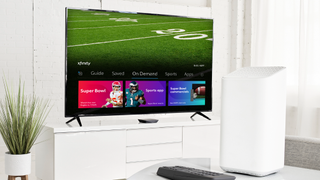Super Bowl LVII will screen in 4K and Dolby Vision, but only on Comcast Xfinity
The first Super Bowl in Dolby Vision HDR

Super Bowl LVII takes place on Sunday, February 12, when football fans will get to see the mighty Kansas City Chiefs take on the equally formidable Philadelphia Eagles. It promises to be a spine-tingling match, one that over 100 million-plus viewers in the US will tune into on TV screens big and small.
The good news this year for owners of the best 4K TVs is that the game will be transmitted in 4K Ultra HD with Dolby Vision high dynamic range. Think of how incredible that will look – every detail, from the mesh of the players' uniforms to the stadium lights bouncing off their helmets should come through with vivid, startling clarity. But there's a catch: only subscribers to Comcast's Xfinity X1 cable service will be able to watch the game in the Dolby Vision HDR format.
According to Dolby, Comcast customers will need a compatible Xfinity X1 cable box and, of course, a compatible TV to experience the Dolby Vision HDR goodness when you watch Super Bowl 2023.
Those who don’t subscribe to Comcast cable won’t be completely shut out of experiencing the game in 4K and HDR, however. Apps like YouTube TV and fuboTV let you stream sports events normally seen via broadcast TV and cable. Many viewers will be watching the game that way on February 12, and Fox Sports, which has broadcast rights to Super Bowl LVII, will also be making the game available in 4K on its Fox Sports app – just not with Dolby Vision. Instead, basic HDR10 high dynamic range will be used, a format that’s supported by virtually all 4K TVs, Dolby Vision-compatible ones included.
But wait – there’s another catch. While the idea of 4K football, with Dolby Vision no less, is thrilling, what Fox Sports will actually be transmitting on February 12 is upconverted regular high-def video. The reason for this is that major sports events like the Super Bowl require a large number of cameras to capture the action from every possible angle – drones included – and 1080p is a more manageable production format than 4K. Fox Sports had already transmitted this year’s NFL playoffs games in upconverted 4K, and it did the same back in 2020, which was the last time the network broadcast the Super Bowl.
Analysis: More sports should be broadcast in 4K – and HDR
Super Bowl LVII getting the Dolby Vision treatment is an interesting development, and one that’s been a long time coming. With TVs generally getting bigger and brighter, and packed with extras such as Dolby Vision HDR, sports fans should expect premium events such as the Super Bowl to be transmitted in the highest possible quality. Even low-cost TVs now support Dolby Vision, and everyone who owns a compatible TV will undoubtedly want to take advantage of this picture quality-boosting feature.
Having the Super Bowl’s Dolby Vision debut limited to a single cable TV service seems odd, however. Viewers have been cutting the cord in droves over the past decade as the best streaming services have stepped up to provide a viable alternative to subscription-based cable TV bundles. I gave mine up years ago and never looked back. But Super Bowl LVII in Dolby Vision is something I would want to see, and I’m now experiencing a pang of regret that I won’t be able to watch the game in the premium HDR format.
Get daily insight, inspiration and deals in your inbox
Get the hottest deals available in your inbox plus news, reviews, opinion, analysis and more from the TechRadar team.
While movies and TVs shows in actual 4K – not upconverted – are easy to come by on streaming services, sports transmitted in 4K have been slow to arrive. The FIFA World Cup was presented in 4K and HDR back in 2022, but it could only be streamed via the BBC iPlayer app. (Fox Sports in the US showed the same, but again upconverted from 1080p, and it was also transmitted in Dolby Vision by Comcast.)
While cable TV providers and streaming services make their slow creep toward presenting sports in 4K and HDR, digital TV broadcasters in the US are proving even more sluggish. The next-gen ATSC 3.0 digital TV standard in the US supports 4K and HDR broadcasting, along with immersive Dolby Atmos audio, but we have yet to see TV stations that have made the transition from the older, HD-only ATSC 1.0 broadcast format take advantage of those capabilities. In fact, the situation has gotten so bad that the National Association of Broadcasters has called the ATSC 3.0 transition “stalled” and asked the FCC to create a taskforce to speed up the process.
Ultra high-definition 4K with HDR is the future of sports broadcasting – our TVs have long supported both, and many streaming services readily provide both for plenty of programming other than sports. Getting to see games in those formats would be a welcome advancement, and while you’re at it broadcasters, please add Dolby Atmos audio to the mix.

Al Griffin has been writing about and reviewing A/V tech since the days LaserDiscs roamed the earth, and was previously the editor of Sound & Vision magazine.
When not reviewing the latest and greatest gear or watching movies at home, he can usually be found out and about on a bike.
Most Popular



